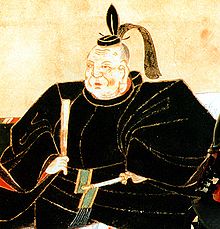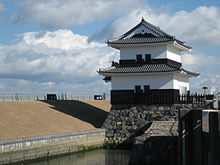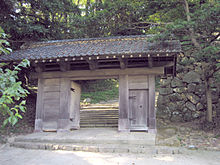- Matsudaira clan
-
Matsudaira clan 
Matsudaira clan crestProvince of origin Mikawa Parent house Minamoto clan Titles Various Founder Matsudaira Chikauji Final ruler Tokugawa Yoshinobu Current head Tokugawa Tsunenari Founding year 14th century Dissolution still extant Cadet branches Various The Matsudaira clan (松平氏 Matsudaira-shi) was a Japanese samurai clan that claimed descent from the Minamoto clan. It first originated in and took its name from Matsudaira village, in Mikawa Province (modern-day Aichi Prefecture). Over the course of its history, the clan produced many branches, most of which also centered around Mikawa Province. In the 16th century, the main Matsudaira line experienced a meteoric rise to success during the headship of Matsudaira Motoyasu, who changed his name to Tokugawa Ieyasu and became the first Tokugawa shogun. Ieyasu's line formed what became the Tokugawa clan; however, the branches retained the Matsudaira surname. Other branches were formed in the decades after Ieyasu, which bore the Matsudaira surname. Some of those branches were also of daimyo status.
After the Meiji Restoration and the abolition of the han system, the Tokugawa and Matsudaira clans became part of the new nobility.
Contents
Origins
The Matsudaira clan originated in Mikawa Province.[1] Its origins are uncertain, but in the Sengoku era, the clan claimed descent from the medieval Seiwa Genji branch of the Minamoto clan. According to this claim, the founder of the Matsudaira line was Matsudaira Chikauji, who lived in the 14th century and established himself in Mikawa Province, at Matsudaira village.
Sengoku period
Main articles: Tokugawa Ieyasu and Sengoku periodMinor power between major neighbors
In its territory in Mikawa Province, the Matsudaira clan was surrounded by much more powerful neighbors. To the west was the territory of the Oda clan of Owari Province; to the east, the Imagawa clan of Suruga. Each generation of Matsudaira family head had to carefully negotiate his relationship with these neighbors.
Branches of the Matsudaira clan
Before the Edo period, there were 19 major branches of the Matsudaira clan: Takenoya (竹谷), Katanohara (形原), Ōgusa (大草), Nagasawa (長沢), Nōmi (能見), Goi (五井), Fukōzu (深溝), Ogyū (大給), Takiwaki (滝脇), Fukama (福釜), Sakurai (桜井), Tōjō (東条), Fujii (藤井), Mitsugi (三木), Iwatsu (岩津), Nishi-Fukama (西福釜), Yata (矢田), Udono (鵜殿), and Kaga (加賀). Each of these branches (with the exception of the Kaga-Matsudaira, which relocated to Kaga Province) took its name from the area in Mikawa where it resided. Also, many of the branches often fought with each other.
The Matsudaira of Okazaki
It was the main Matsudaira line residing in Okazaki Castle which rose the highest during the Sengoku period. During the headship of Matsudaira Hirotada, it was threatened by the Oda and Imagawa clans, and for a time was forcibly brought into Imagawa service. After the death of Imagawa Yoshimoto and the fall from power of the Imagawa clan, Hirotada's son Matsudaira Motoyasu was successful in forming an alliance with Oda Nobunaga, the hegemon of Owari Province. Motoyasu is better known as Tokugawa Ieyasu, who became the first Tokugawa shogun in 1603.
Matsudaira branches and the use of the surname
Pre-Edo branches
Several of the pre-Edo branch families survived into the Edo period; some of them became daimyo. The Takiwaki-Matsudaira family became daimyo of the Ojima Domain, and from 1868-1871, ruled the Sakurai Domain. The Nagasawa-Matsudaira, also known as the Ōkōchi-Matsudaira, had several branches, one of them ruled the Yoshida Domain of Mikawa Province.[2] A prominent Nagasawa-Matsudaira is the early Edo period politician Matsudaira Nobutsuna. The Fukōzu-Matsudaira ruled the Shimabara Domain. The Sakurai-Matsudaira ruled the Amagasaki Domain.[3] The Ogyū-Matsudaira had many branches, one of which ruled the Okutono Domain. Nagai Naoyuki was a prominent Bakumatsu-era descendant of the Ogyū-Matsudaira of Okutono. Other pre-Edo branches of the family became hatamoto.
Tokugawa branches and the Matsudaira surname
The Tokugawa surname was not granted to all of the sons of the shogun or the heads of the six main Tokugawa branches. Only the inheritor received the Tokugawa name, while all of his siblings would receive the Matsudaira surname. For example, the last shogun Tokugawa Yoshinobu was not the firstborn heir of his father (Tokugawa Nariaki of Mito). Consequently, Yoshinobu was known as Matsudaira Shichirōma during his minority. Some of these sons, particularly of the 3 main Tokugawa branches (the Gosanke), formed their own families, and received their own fiefs. These included Takamatsu,[4] Shishido,[5], Fuchū,[6] and Moriyama[7] (branches of the Mito Tokugawa); Saijō (a branch of the Kii Tokugawa);[8] and Takasu (a branch of the Owari Tokugawa).[9] Notable Matsudaira of these branches include Matsudaira Yoritoshi of Takamatsu, and Matsudaira Yoritaka of Fuchū. Yoritsune Matsudaira and his son Yoriaki Matsudaira, who were 20th century composers, were descendants of the Matsudaira of Fuchū.
Yūki-Matsudaira clan (Echizen)
Main articles: Fukui Domain and Tsuyama DomainThe Yūki-Matsudaira clan was founded by Tokugawa Ieyasu's son Yūki Hideyasu.[10] Several branches of the Yūki-Matsudaira came into existence during the Edo period. Though the Yūki-Matsudaira retained control of Kitanoshō (later renamed Fukui), the main Yūki line was not there, but in Tsuyama instead. Branches of the family ruled the Fukui, Hirose, Mori, Matsue, Tsuyama, Akashi, Itoigawa, and Maebashi domains. Famous Yūki-Matsudaira include Matsudaira Naritami[11] and Matsudaira Yoshinaga, two daimyo of the late Edo period. Matsudaira Yoshinaga in particular was very important to Japanese politics of the early Meiji period, and his leadership put the Fukui Domain on the side of the victors in the Boshin War (1868-69).
Hisamatsu-Matsudaira clan
Main article: Kuwana DomainThe Hisamatsu-Matsudaira clan was founded by Tokugawa Ieyasu's half-brother Hisamatsu Sadakatsu. Due to his close relation to Ieyasu, Sadakatsu was allowed the use of the Matsudaira surname. Eventually, some of the branches of the Hisamatsu-Matsudaira were also allowed the use of the Tokugawa family crest, as well as being formally recognized as Tokugawa relatives (shinpan), rather than simply being a fudai family. Branches of the Hisamatsu-Matsudaira ruled the Kuwana,[12] Imabari,[13] and Iyo-Matsuyama domains.[14] Famous Hisamatsu-Matsudaira include the political reformer Matsudaira Sadanobu, the final Kyoto Shoshidai Matsudaira Sadaaki, and shogunate politician Itakura Katsukiyo. In the Meiji era, the heads of all the Hisamatsu-Matsudaira branches received titles in the new nobility.[15]
Ochi-Matsudaira clan
The Ochi-Matsudaira clan was founded by Matsudaira Kiyotake, the younger brother of the 6th shogun Tokugawa Ienobu.[16] The Ochi-Matsudaira ruled the Hamada Domain. The family lost most of its territory in 1866, when the castle town was occupied by Chōshū Domain forces under Ōmura Masujirō during the Chōshū War. Matsudaira Takeakira, the last daimyo, escaped Hamada and went to Tsuruta, one of the domain's non-contiguous territories; there he set up the Tsuruta Domain, which existed until the abolition of the domains in 1871. In the Meiji era, Takeakira's son Matsudaira (Ochi) Takenaga received the title of viscount.[15]
Hoshina-Matsudaira clan (Aizu)
Main article: Aizu DomainThe Hoshina-Matsudaira clan was founded by Hoshina Masayuki. Masayuki, a son of the second shogun Tokugawa Hidetada, was adopted by Hoshina Masamitsu, the lord of the Takatō Domain. Masayuki was recognized as a relative of the Tokugawa family by his half-brother Tokugawa Iemitsu; after Iemitsu's death, Masayuki served as a regent for his nephew, the underaged shogun Tokugawa Ietsuna, thus effectively running the shogunate. It was at this time that Masayuki received rulership of the fief of Aizu (with an income of 230,000 koku). Two generations later, during the reign of the 3rd lord Masakata, the family was allowed the use of the Matsudaira surname and crest. The family remained prominent in shogunate affairs and in security duty in Ezo (Hokkaido). It also sponsored several schools of martial arts, as well as working to develop and spread the production of local crafts. In the Bakumatsu period, the 8th lord Matsudaira Katataka assisted with security duties during and after the arrival of Matthew C. Perry's US Navy vessels; Katataka's successor, 9th lord Matsudaira Katamori served as Kyoto Protector, but his clan was later defeated in the Boshin War. The Aizu-Matsudaira survived the Meiji Restoration, and were ennobled with the title of viscount.[15] Katamori's son Matsudaira Morio served as an admiral in the Imperial Japanese Navy. The family survives to the present day. Isao Matsudaira, who was governor of Fukushima Prefecture in the 1980s, was a descendant of this family. Princess Chichibu Setsuko, the wife of Emperor Hirohito's brother Prince Chichibu Yasuhito, was another.
Matsudaira as an honorific
Over the course of the Edo period, the Tokugawa shogunate granted the use of the Matsudaira surname to certain families as an honorific. These families included both fudai and tozama daimyo families. The Date clan of Sendai,[17] the Shimazu clan of Satsuma,[18] the Mōri clan of Choshu, the Maeda clan of Kaga (and its branches at Daishōji and Toyama), the Yamanouchi clan of Tosa, the Kuroda clan of Fukuoka, the Asano clan of Hiroshima (and its branch at Hiroshima-shinden), the Nabeshima of Saga, the Ikeda of Tottori (as well as its branches of Okayama, Shikano, Wakazakura, Hirafuku, as well as hatamoto-level Ikeda), and the Hachisuka of Tokushima were all tozama families that had the use of the Matsudaira surname. The Yanagisawa clan of Yamato[19] and Honjō clan of Miyazu were two fudai families among those who had the right to use the Matsudaira surname. In addition, if a Tokugawa princess married into another family, her husband had the right to use the Matsudaira surname and the Tokugawa crest for one generation.
Matsudaira in the present day
Prominent Matsudaira in the present day include Matsudaira Ryūmon (actor) and Matsudaira Sadatomo (anchor for NHK), among others.
Key Genealogies
Main line (Tokugawa shogun)
- Serata Arichika
- Matsudaira Chikauji
- Matsudaira Yasuuji
- Matsudaira Nobumitsu
- Matsudaira Chikatada (1431-1501)
- Matsudaira Nagachika (1473-1544)
- Matsudaira Nobutada (1486-1531)
- Matsudaira Kiyoyasu (1511-1535)
- Matsudaira Hirotada (1526-1549)
- Tokugawa Ieyasu (1543-1616)
- Tokugawa Hidetada (1579-1632)
- Tokugawa Iemitsu (1604-1651)
- Tokugawa Ietsuna (1641-1680)
- Tokugawa Tsunayoshi (1646-1709)
- Tokugawa Ienobu (1662-1712)
- Tokugawa Ietsugu (1709-1716)
- Tokugawa Yoshimune (1684-1751)
- Tokugawa Ieshige (1712-1761)
- Tokugawa Ieharu (1737-1786)
- Tokugawa Ienari (1773-1841)
- Tokugawa Ieyoshi (1793-1853)
- Tokugawa Iesada (1824-1858)
- Tokugawa Iemochi (1846-1866)
- Tokugawa Yoshinobu (1837-1913)
- Tokugawa Iesato (1863-1940)
- Tokugawa Iemasa (1884-1963)
- Tokugawa Tsunenari (1940-)
Hoshina-Matsudaira clan (Aizu)
- Hoshina Masayuki (1611-1673)
- Hoshina Masatsune (1647-1681)
- Matsudaira Masakata (1669-1731)
- Matsudaira Katasada (1724-1750)
- Matsudaira Katanobu (1744-1805)
- Matsudaira Kataoki (1779-1806)
- Matsudaira Katahiro (1803-1822)
- Matsudaira Katataka (1806-1852)
- Matsudaira Katamori (1836-1893)
- Matsudaira Nobunori (1855-1891)
- Matsudaira Kataharu (1869-1910)
- Matsudaira Morio (1878-1944)
- Matsudaira Morisada (1926-)
- Matsudaira Morihisa
Yūki-Matsudaira clan (Echizen)
- Yūki Hideyasu (1574-1607)
- Matsudaira Tadanao (1595-1650)
- Matsudaira Tadamasa (1598-1645)
- Matsudaira Mitsumichi (1636-1674)
- Matsudaira Masachika (1640-1711)
- Matsudaira Tsunamasa (1661-1699)
- Yoshinori (the former Masachika)
- Matsudaira Yoshikuni (1681-1722)
- Matsudaira Munemasa (1675-1724)
- Matsudaira Munenori (1715-1749)
- Matsudaira Shigemasa (1743-1758)
- Matsudaira Shigetomi (1748-1809)
- Matsudaira Haruyoshi (1768-1826)
- Matsudaira Naritsugu (1811-1835)
- Matsudaira Narisawa (1820-1838)
- Matsudaira Yoshinaga (1828-1890)
- Matsudaira Mochiaki (1836-1890)
Ochi-Matsudaira clan (Hamada)
- Matsudaira Kiyotake (1663-1724)
- Matsudaira Takemasa (1702-1728)
- Matsudaira Takemoto (1714-1779)
- Matsudaira Takehiro (1754-1789)
- Matsudaira Nariatsu (1783-1839)
- Matsudaira Takeoki (1827-1842)
- Matsudaira Takeshige (1825-1847)
- Matsudaira Takeakira (1842-1882)
- Matsudaira Takenaga
Hisamatsu-Matsudaira clan (Kuwana)
- Matsudaira Sadatsuna (1592-1652)
- Matsudaira Sadayoshi (1632-1657)
- Matsudaira Sadashige (1644-1717)
- Matsudaira Sadamichi (1677-1718)
- Matsudaira Sadateru (1704-1725)
- Matsudaira Sadanori (1680-1727)
- Matsudaira Sadayoshi (1709-1770)
- Matsudaira Sadakuni (1720-1790)
- Matsudaira Sadanobu (1759-1829)
- Matsudaira Sadanaga (1791-1838)
- Matsudaira Sadakazu (1812-1841)
- Matsudaira Sadamichi (1831-1859)
- Matsudaira Sadaaki (1847-1908)
- Matsudaira Sadanori (1857-1899)
Ogyū-Matsudaira clan (Okutono)
- Matsudaira Sanetsugu
- Matsudaira Noritsugu (1632-1687)
- Matsudaira Norinari (1658-1703)
- Matsudaira Norizane (1686-1716)
- Matsudaira Mitsunori (1716-1742)
- Matsudaira Noriyasu (1739-1783)
- Matsudaira Noritomo (1760-1824)
- Matsudaira Noritada (1777-1818)
- Matsudaira Noriyoshi (1791-1827)
- Matsudaira Noritoshi (1811-1854)
- Matsudaira Norikata (1839-1910)
- Matsudaira Noritake
Gallery
Notes
- ^ Thornton, Charisma and Community Formation in Medieval Japan, p. 148.
- ^ Totman, Politics in the Tokugawa bakufu, p. 346.
- ^ (Japanese) "Amagasaki-han" on Edo 300 HTML (accessed 24 August 2008).
- ^ (Japanese)"Takamatsu-han" on Edo 300 HTML (accessed 27 August 2008)
- ^ (Japanese) "Shishido-han" on Edo 300 HTML (accessed 27 August 2008)
- ^ (Japanese) "Fuchū-han" on Edo 300 HTML (accessed 27 August 2008)
- ^ (Japanese) "Moriyama-han" on Edo 300 HTML (accessed 27 August 2008)
- ^ (Japanese) "Saijō-han" on Edo 300 HTML (accessed 27 August 2008)
- ^ (Japanese) "Takasu-han" on Edo 300 HTML (accessed 27 August 2008)
- ^ "Tokugawa shogun-ke to Matsudaira ichizoku," p. 165.
- ^ "Tokugawa Shōgun-ke to Matsudaira Ichizoku," p. 231.
- ^ (Japanese) "Kuwana-han" on Edo 300 HTML (accessed 24 August 2008).
- ^ (Japanese) "Imabari-han" on Edo 300 HTML (accessed 24 August 2008).
- ^ (Japanese) "Iyo-Matsuyama han" on Edo 300 HTML (accessed 24 August 2008).
- ^ a b c (German) List of Meiji-era Japanese nobility (accessed 15 August 2008)
- ^ "Tokugawa shogun-ke to Matsudaira ichizoku," p. 220.
- ^ "Tokugawa shogun-ke to Matsudaira ichizoku," p. 184.
- ^ "Tokugawa shogun-ke to Matsudaira ichizoku," p. 196.
- ^ "Tokugawa shogun-ke to Matsudaira ichizoku," p. 183.
References
English
- Thornton, Sybil A. (1999). Charisma and Community Formation in Medieval Japan. Charlottesville: University of Virginia Press.
- Totman, Conrad (1967). Politics in the Tokugawa bakufu. Cambridge: Harvard University Press.
German
- List of Meiji-era Japanese nobility (accessed 15 August 2008).
Japanese
- "Imabari-han" on Edo 300 HTML (accessed 24 August 2008).
- "Iyo-Matsuyama han" on Edo 300 HTML (accessed 24 August 2008).
- "Kuwana-han" on Edo 300 HTML (accessed 24 August 2008).
- "Tokugawa Shōgun-ke to Matsudaira Ichizoku", Rekishi Dokuhon magazine, January 2006.
See also
Wikimedia Foundation. 2010.













